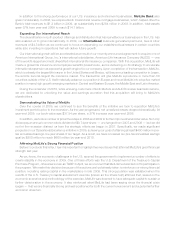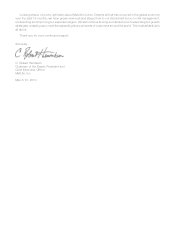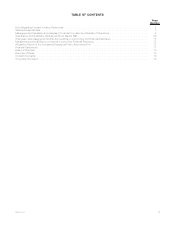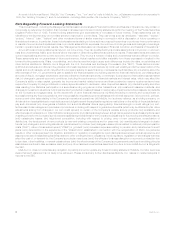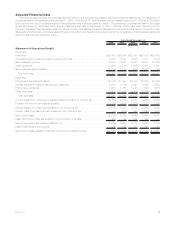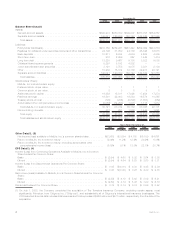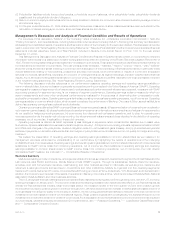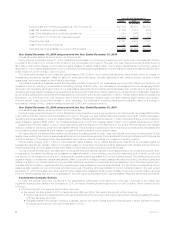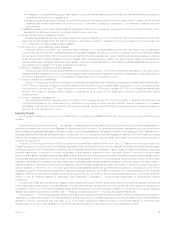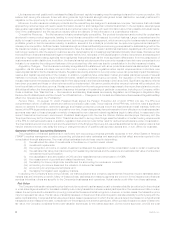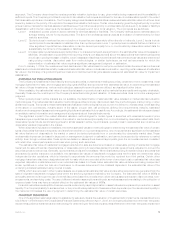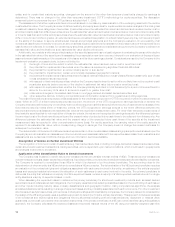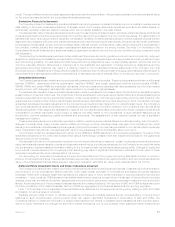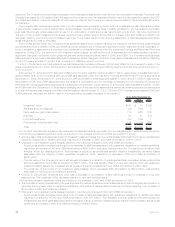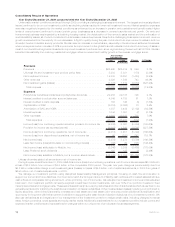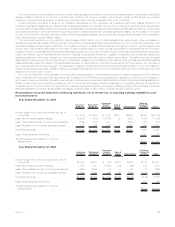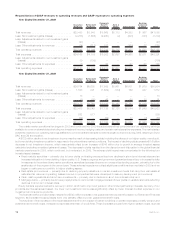MetLife 2009 Annual Report Download - page 14
Download and view the complete annual report
Please find page 14 of the 2009 MetLife annual report below. You can navigate through the pages in the report by either clicking on the pages listed below, or by using the keyword search tool below to find specific information within the annual report.Life insurers are well positioned to address the Baby Boomers’ rapidly increasing need for savings tools and for income protection. We
believe that, among life insurers, those with strong brands, high financial strength ratings and broad distribution, are best positioned to
capitalize on the opportunity to offer income protection products to Baby Boomers.
Moreover, the life insurance industry’s products and the needs they are designed to address are complex. We believe that individuals
approaching retirement age will need to seek information to plan for and manage their retirements and that, in the workplace, as employees
take greater responsibility for their benefit options and retirement planning, they will need information about their possible individual needs.
One of the challenges for the life insurance industry will be the delivery of this information in a cost effective manner.
Competitive Pressures. The life insurance industry remains highly competitive. The product development and product life-cycles have
shortened in many product segments, leading to more intense competition with respect to product features. Larger companies have the
ability to invest in brand equity, product development, technology and risk management, which are among the fundamentals for sustained
profitable growth in the life insurance industry. In addition, several of the industry’s products can be quite homogeneous and subject to
intense price competition. Sufficient scale, financial strength and financial flexibility are becoming prerequisites for sustainable growth in the
life insurance industry. Larger market participants tend to have the capacity to invest in additional distribution capability and the information
technology needed to offer the superior customer service demanded by an increasingly sophisticated industry client base. We believe that
the turbulence in financial markets that began in the latter half of 2008, its impact on the capital position of many competitors, and subsequent
actions by regulators and rating agencies have highlighted financial strength as the most significant differentiator from the perspective of
customers and certain distributors. In addition, the financial market turbulence and the economic recession have led many companies in our
industry to re-examine the pricing and features of the products they offer and may lead to consolidation in the life insurance industry.
Regulatory Changes. The life insurance industry is regulated at the state level, with some products and services also subject to federal
regulation. As life insurers introduce new and often more complex products, regulators refine capital requirements and introduce new
reserving standards for the life insurance industry. Regulations recently adopted or currently under review can potentially impact the statutory
reserve and capital requirements of the industry. In addition, regulators have undertaken market and sales practices reviews of several
markets or products, including equity-indexed annuities, variable annuities and group products. The regulation of the financial services
industry has received renewed scrutiny as a result of the disruptions in the financial markets in 2008 and 2009. Significant regulatory reforms
have been proposed and these or other reforms could be implemented. We cannot predict whether any such reforms will be adopted, the
form they will take or their effect upon us. We also cannot predict how the various government responses to the recent financial and economic
difficulties will affect the financial services and insurance industries or the standing of particular companies, including our Company, within
those industries. See “Risk Factors — Our Insurance and Banking Businesses Are Heavily Regulated, and Changes in Regulation May
Reduce Our Profitability and Limit Our Growth” and “Risk Factors — Changes in U.S. Federal and State Securities Laws and Regulations May
Affect Our Operations and Our Profitability.”
Pension Plans. On August 17, 2006, President Bush signed the Pension Protection Act of 2006 (“PPA”) into law. The PPA is a
comprehensive reform of defined benefit and defined contribution plan rules. The provisions of the PPA may, over time, have a significant
impact on demand for pension, retirement savings, and lifestyle protection products in both the institutional and retail markets. While the
impact of the PPA is generally expected to be positive over time, these changes may have adverse short-term effects on our business as plan
sponsors may react to these changes in a variety of ways as the new rules and related regulations begin to take effect. In response to the
current financial and economic environment, President Bush signed into the law the Worker, Retiree and Employer Recovery Act (the
“Employer Recovery Act”) in December 2008. This Act is intended to, among other things, ease the transition of certain funding requirements
of the PPA for defined benefit plans. In addition, legislation that would provide further relief for defined benefit plans is under consideration.
The financial and economic environment and the enactment of the Employer Recovery Act, as well as additional funding relief provisions that
may be enacted into law, may delay the timing or change the nature of qualified plan sponsor actions and, in turn, affect our business.
Summary of Critical Accounting Estimates
The preparation of financial statements in conformity with accounting principles generally accepted in the United States of America
(“GAAP”) requires management to adopt accounting policies and make estimates and assumptions that affect amounts reported in the
consolidated financial statements. The most critical estimates include those used in determining:
(i) the estimated fair value of investments in the absence of quoted market values;
(ii) investment impairments;
(iii) the recognition of income on certain investment entities and the application of the consolidation rules to certain investments;
(iv) the estimated fair value of and accounting for freestanding derivatives and the existence and estimated fair value of embedded
derivatives requiring bifurcation;
(v) the capitalization and amortization of DAC and the establishment and amortization of VOBA;
(vi) the measurement of goodwill and related impairment, if any;
(vii) the liability for future policyholder benefits and the accounting for reinsurance contracts;
(viii) accounting for income taxes and the valuation of deferred tax assets;
(ix) accounting for employee benefit plans; and
(x) the liability for litigation and regulatory matters.
In applying the Company’s accounting policies, we make subjective and complex judgments that frequently require estimates about
matters that are inherently uncertain. Many of these policies, estimates and related judgments are common in the insurance and financial
services industries; others are specific to the Company’s businesses and operations. Actual results could differ from these estimates.
Fair Value
The Company defines fair value as the price that would be received to sell an asset or paid to transfer a liability (an exit price) in the principal
or most advantageous market for the asset or liability in an orderly transaction between market participants on the measurement date. In many
cases, the exit price and the transaction (or entry) price will be the same at initial recognition. However, in certain cases, the transaction price
may not represent fair value. The fair value of a liability is based on the amount that would be paid to transfer a liability to a third-party with the
same credit standing. It requires that fair value be a market-based measurement in which the fair value is determined based on a hypothetical
transaction at the measurement date, considered from the perspective of a market participant. When quoted prices are not used to determine
fair value, the Company considers three broad valuation techniques: (i) the market approach, (ii) the income approach, and (iii) the cost
8MetLife, Inc.


